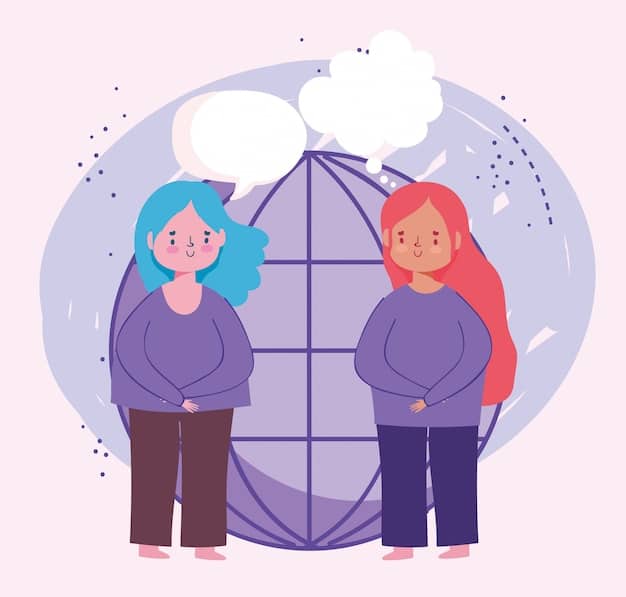Recognizing Depression Signs: A US Guide for Adults & Teens

Recognizing the signs of depression in US adults and teens involves understanding persistent mood changes, shifts in behavior, and physical symptoms that significantly impact daily life, necessitating awareness to encourage timely support and intervention.
In the United States, understanding mental well-being has become increasingly vital, particularly when addressing conditions like depression. For many, the subtle and sometimes overt indicators of this often-debilitating disorder can be difficult to discern. This guide aims at equipping US adults and teens with the knowledge to begin recognizing the signs of depression: a guide for US adults and teens, fostering an environment where early identification can lead to impactful support and recovery.
Understanding depression in the US context
Depression, clinical depression, or major depressive disorder, is more than just feeling sad. It’s a serious medical illness that negatively affects how you feel, the way you think, and how you act. Fortunately, it is also treatable. Depression causes feelings of sadness and/or a loss of interest in activities once enjoyed. It can lead to a variety of emotional and physical problems and can decrease a person’s ability to function at work and at home.
In the United States, depression affects millions of people across all age groups, with specific nuances in how it manifests and is perceived among adults versus teenagers. While the core symptoms remain similar, the societal pressures, developmental stages, and access to resources can influence how these signs are exhibited and recognized. For adults, work-related stress, family responsibilities, and life transitions often play a significant role, while teenagers navigate academic pressures, social dynamics, and identity formation.
Prevalence and impact on US demographics
The prevalence of depression in the US highlights a significant public health challenge. According to the National Institute of Mental Health (NIMH), millions of US adults experience depression annually. Among adolescents, the statistics are equally concerning, with a substantial percentage of young people reporting a major depressive episode in the past year. These figures underscore the widespread impact of depression, affecting individuals regardless of their socio-economic status, ethnic background, or geographic location.
- 📈 Mental health statistics indicate a rising trend in depressive episodes among younger populations.
- 🏥 Access to mental healthcare varies significantly across states and rural/urban areas.
- 🗣️ Stigma around mental health remains a barrier to seeking help for many.
The economic and social repercussions of depression are profound, impacting productivity, relationships, and overall quality of life. For individuals and families, the burden can be immense, requiring extensive support systems and often complex treatment plans. Recognizing the collective impact of this condition is the first step toward developing more effective community-based solutions and promoting mental wellness on a broader scale.
This section serves as a foundational understanding, setting the stage for a deeper dive into the specific signs and symptoms, tailored to the unique experiences of adults and teens in the US. By acknowledging the pervasive nature of depression, we can approach its recognition with the sensitivity and urgency it demands.
Emotional indicators: beyond fleeting sadness
While everyone experiences sadness or low moods from time to time, depression’s emotional indicators are distinctively persistent and pervasive. These aren’t transient feelings but rather a deep, enduring sense of despair or emptiness that colors every aspect of life. It’s crucial to distinguish between a bad day and a pattern of emotional distress that warrants attention, especially for US adults and teens facing various life stressors.
For adults, this might manifest as a profound lack of joy in activities once cherished, feelings of worthlessness, or an overwhelming sense of guilt unrelated to specific events. Teenagers, on the other hand, might exhibit irritability, anger, or extreme sensitivity, rather than overt sadness. Their emotional landscape can be volatile, making it harder to discern what is typical adolescent angst versus a deeper underlying issue.
Core emotional symptoms to look for
The cornerstone of emotional depression symptoms often revolves around a persistent low mood and anhedonia—the inability to feel pleasure. For an extended period, typically two weeks or more, these feelings dominate an individual’s emotional state. It’s not just a passing phase; it’s a constant companion that overshadows positive experiences and makes even small tasks seem insurmountable.
- 😩 Persistent sad, anxious, or “empty” mood.
- ❌ Loss of interest or pleasure in hobbies and activities.
- 😤 Irritability, frustration, or restlessness, especially in teens.
- 📉 Feelings of hopelessness or pessimism about the future.
Beyond these core indicators, individuals may experience intense feelings of guilt or worthlessness, often disproportionate to their circumstances. These negative self-perceptions can cripple self-esteem and lead to social withdrawal, perpetuating a downward spiral. The emotional turmoil can also manifest as thoughts about death or suicide, a critical red flag that always requires immediate attention and professional intervention.
It’s important to remember that these emotional shifts are not a sign of weakness, but symptoms of a treatable illness. Empathy and understanding from friends, family, and educators are vital in encouraging individuals to seek help. This emotional landscape, when recognized, can guide caregivers and individuals toward appropriate support systems and therapeutic pathways, fostering an atmosphere of hope and recovery.
Behavioral changes: subtle shifts and noticeable patterns
Beyond the internal emotional landscape, depression often manifests through discernible behavioral changes. These shifts can be subtle at first, gradually intensifying, or they can appear quite suddenly, signaling a significant shift in an individual’s daily functioning. Observing these patterns, particularly in US adults and teens, is key to recognizing the broader picture of depressive symptoms.
For adults, behavioral changes might include withdrawing from social interactions, showing up late or missing work, or neglecting personal hygiene. They may stop engaging in hobbies or activities they once enjoyed, leading to increased isolation. Teenagers might exhibit similar withdrawal, but also a noticeable drop in academic performance, increased truancy, or a change in peer groups towards those who engage in risky behaviors.

Key behavioral indicators
A significant sign of depression is a change in sleep patterns. This can range from insomnia (difficulty falling or staying asleep) to hypersomnia (sleeping excessively). Both extremes can severely disrupt daily life and exacerbate other symptoms. Eating habits also often change, leading to either significant weight loss or gain due to a loss of appetite or emotional eating.
- 😴 Significant changes in sleep patterns (insomnia or hypersomnia).
- 🍽️ Noticeable changes in appetite and weight (loss or gain).
- 🚶 Sluggishness, agitation, or decreased energy levels.
- 🚫 Social withdrawal and isolation from friends and family.
Additionally, individuals with depression may exhibit a general slowing down of movements, speech, and thought processes, known as psychomotor retardation. Conversely, some may experience restlessness or agitation, constantly pacing or fidgeting. These physical manifestations of distress can be particularly telling. For teens, a sudden decline in school performance, increased risk-taking behavior, or a pervasive lack of motivation in all areas of life are strong indicators.
It’s vital for those around an individual showing these signs to offer support without judgment. Encouraging open communication and suggesting professional evaluation can make a profound difference. These behavioral patterns are not just quirks; they are often direct manifestations of the internal struggle with depression and require compassionate attention.
Cognitive symptoms: the mind’s burdens
Depression doesn’t just affect emotions and behaviors; it profoundly impacts cognitive function, clouding thinking and impairing concentration. These cognitive symptoms can be particularly distressing, making it difficult for US adults to perform at work or manage household tasks, and for teens to focus on their studies or engage effectively in social settings. The mind, burdened by depression, struggles to process information clearly or make decisions efficiently.
Adults might report difficulty remembering things, struggling to concentrate on detailed tasks, or feeling overwhelmed by what used to be simple choices. For teenagers, this could translate into significant challenges with schoolwork, difficulty following instructions, or an apparent inability to organize their thoughts, leading to frustration and further withdrawal.
Common cognitive challenges
One of the most frequently reported cognitive symptoms is difficulty concentrating. This can make activities like reading a book, watching a movie, or even following a conversation feel like insurmountable challenges. The mind often feels foggy or sluggish, impeding the ability to process information efficiently. Decision-making, which typically relies on clear thinking, becomes arduous and fraught with anxiety, leading to indecisiveness even over minor issues.
- 🧠 Difficulty concentrating, remembering, or making decisions.
- 🌫️ Feeling “slowed down” or having a “foggy” mind.
- 🤯 Thoughts of worthlessness, guilt, or self-blame.
- 💀 Recurrent thoughts of death or suicide (seek immediate help).
Beyond these, individuals often experience distorted thinking patterns. Negative self-talk, unwarranted self-blame, and a pervasive sense of hopelessness contribute to a cycle of despair. They might dwell on perceived failures or shortcomings, amplifying their severity and minimizing any successes. This distorted perception can make it difficult for them to see a way out of their depressive state, reinforcing feelings of helplessness.
Recognizing these cognitive burdens is critical because they often reinforce other symptoms of depression, creating a self-perpetuating cycle. Encouraging mental engagement through simple tasks, providing supportive environments free from excessive pressure, and advocating for professional cognitive behavioral therapies can help mitigate these effects. Addressing the cognitive aspects of depression is paramount to restoring an individual’s ability to function and thrive.
Physical manifestations: depression’s hidden body language
While often perceived as a purely mental health condition, depression frequently presents with a range of physical symptoms that can be puzzling and debilitating if their connection to mental well-being isn’t recognized. These somatic complaints are not merely imagined but are tangible expressions of chronic stress and physiological imbalance within the body. Paying attention to these physical signs is crucial for both US adults and teens, as they can sometimes be the first or most prominent indicators that something is amiss below the surface.
Adults might complain of persistent headaches, unexplained back pain, or digestive issues that don’t respond to conventional treatments. They may feel chronically fatigued or suffer from muscle aches without clear physical exertion. For teenagers, these physical symptoms might be dismissed as ‘growing pains’ or attributed to poor lifestyle choices, thus delaying proper diagnosis and intervention.
Unexplained aches, pains, and fatigue
One of the most common physical symptoms of depression is persistent fatigue and a significant decrease in energy levels. This isn’t just ordinary tiredness that sleep can cure; it’s a profound exhaustion that drains vitality and makes even simple daily activities feel incredibly taxing. Individuals might find themselves constantly drained, despite adequate rest, and struggle to initiate or complete tasks.
- 😴 Persistent fatigue and decreased energy.
- 🤕 Unexplained aches and pains (headaches, muscle aches, back pain).
- stomach issues (constipation or diarrhea) or digestive problems.
- 📉 Changes in sex drive or interest in physical intimacy.
Beyond fatigue, many people with depression experience chronic, unexplained physical pain. This can include anything from recurrent headaches and migraines to widespread muscle aches, joint pain, or back pain that doctors struggle to diagnose or treat effectively. Digestive problems, such as irritable bowel syndrome, constipation, or diarrhea, are also common, often exacerbated by the stress and anxiety accompanying depression. For some, changes in sex drive, either a decrease or, less commonly, an increase, can also be a significant physical manifestation.
It’s important to remember that these physical symptoms are real and can be extremely distressing. They are not merely psychosomatic, but genuine expressions of the body reacting to profound emotional and mental distress. For those observing these signs, it’s vital to encourage a holistic approach to medical evaluation, one that considers the interconnectedness of physical and mental health. Addressing these physical manifestations can provide significant relief and contribute to overall recovery from depression.
Seeking help and fostering resilience
Recognizing the signs of depression is only the first step. The critical subsequent step is seeking appropriate help and, subsequently, fostering resilience. In the US, a wide array of resources and treatment options are available, but navigating them can be challenging, particularly given the persistent stigma around mental health. Encouraging open dialogue and providing clear pathways to support are paramount for both adults and teens.
For adults, this might involve reaching out to a primary care physician, a therapist, or leveraging employer-sponsored mental health programs. Teenagers often benefit from discussions with school counselors, trusted adults, or engaging with youth mental health initiatives. The emphasis should always be on validating their experiences and ensuring they feel supported in their journey toward recovery.
Pathways to support and healing
The journey to recovery often begins with a conversation. For many, speaking with a doctor is a good starting point. They can rule out underlying medical conditions, provide initial guidance, and refer to mental health specialists. Options include psychotherapy (talk therapy), medication, or a combination of both. Cognitive Behavioral Therapy (CBT) and Interpersonal Therapy (IPT) are commonly used and highly effective.
- Talk to a trusted adult, school counselor, or primary care doctor.
- Explore therapy options like CBT or IPT.
- Consider medication as prescribed by a mental health professional.
- Utilize crisis hotlines or mental health support organizations.
Building resilience involves more than just treatment; it includes developing coping mechanisms, establishing a strong support network, and engaging in self-care practices. This can include regular exercise, a balanced diet, adequate sleep, mindfulness, and pursuing hobbies and interests. For teenagers, this might also involve learning stress management techniques and developing healthy social connections.
Finally, dispelling the myth that seeking help reveals weakness is crucial. It is, in fact, an act of immense strength and self-care. The landscape of mental health support in the US is continually evolving, with increasing emphasis on early intervention and destigmatization. By actively seeking and encouraging support, individuals and communities can cultivate an environment where both adults and teens can not only recover from depression but also build lasting resilience for their overall well-being.
| Key Point | Brief Description |
|---|---|
| 😥 Emotional Indicators | Persistent sadness, loss of interest (anhedonia), feelings of hopelessness. |
| 🔄 Behavioral Changes | Changes in sleep/appetite, social withdrawal, decreased energy or agitation. |
| 🧠 Cognitive Symptoms | Difficulty concentrating, memory issues, indecisiveness, negative thought patterns. |
| 🤒 Physical Manifestations | Unexplained aches, chronic fatigue, digestive issues, changes in sex drive. |
Frequently Asked Questions
▼
Sadness is a normal human emotion usually triggered by specific events and is temporary. Depression is a persistent mental health disorder characterized by an intense and prolonged feeling of sadness, loss of interest, and other symptoms that interfere with daily life, often lasting for weeks or more.
▼
While moodiness is common in teens, signs of depression include prolonged irritability, anger, persistent sadness, social withdrawal, significant changes in sleep/appetite, a drop in grades, or talk of hopelessness/self-harm. These patterns are more severe than typical adolescent mood swings.
▼
Depression can manifest physically through chronic fatigue, unexplained aches and pains (headaches, muscle pain), digestive problems, and changes in appetite leading to significant weight fluctuations. These symptoms are often real, not imagined, and warrant medical attention.
▼
Professional help should be sought if symptoms of depression persist for more than two weeks, significantly interfere with daily functioning, or if thoughts of self-harm or suicide are present. Early intervention is crucial for effective treatment and recovery.
▼
In the US, resources include primary care physicians, therapists (psychologists, psychiatrists), crisis hotlines (e.g., 988 Suicide & Crisis Lifeline), mental health organizations (NAMI, Mental Health America), and school counselors. Employer-sponsored programs and community clinics also offer support.
Conclusion
Recognizing the signs of depression: a guide for US adults and teens is a foundational step in addressing this pervasive public health challenge. By understanding the intricate tapestry of emotional, behavioral, cognitive, and physical symptoms, individuals, families, and communities can foster environments of empathy and proactive support. Depression is a complex, treatable illness, and its early identification paves the way for effective interventions and ultimately, for individuals to reclaim their vitality and well-being. The journey to recovery, while unique for everyone, consistently begins with awareness, allowing for the crucial steps of seeking help and cultivating resilience.





